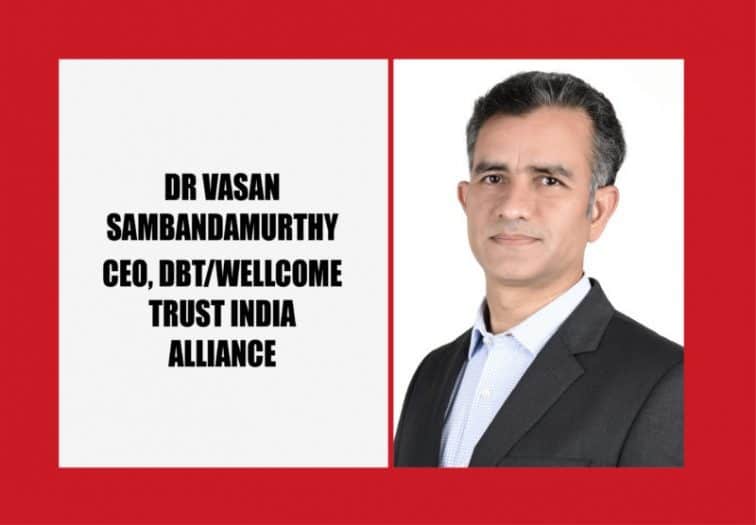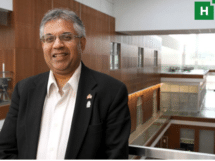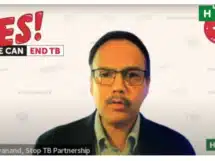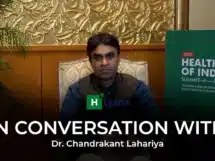In India, funding agencies should focus on building an ecosystem for collaborative and interdisciplinary research, Dr Vasan Sambandamurthy, CEO, DBT/Wellcome Trust India Alliance tells Deepika Khurana in an exclusive interview.
While, as the world continues to battle the deadly COVID-19 virus alongside the economic crisis and healthcare crisis, Dr. Vasan Sambandamurthy, who has recently taken over the role of the Chief Executive Officer of DBT/Wellcome Trust India Alliance, prefers to remain optimistic about India’s potential in the post-COVID world.
“I think the time is opportune for India to unlock its tremendous potential and make giant strides to leverage its capabilities for biomedical science and innovation,” said Dr. Sambandamurthy. He joins the India Alliance with over two decades of experience in vaccine and drug discovery.
According to Dr. Sambandamurthy, the Indian pharmaceutical industry continues to be the world’s largest supplier of generic drugs with a global market share of around 20% in terms of volume and 1.5% in terms of value. “In fact, over 60% of global vaccine demands are supplied by Indian vaccine manufacturers,” he said.
In an exclusive interview with Health Analytics Asia, Dr. Vasan Sambandamurthy, who had previously held leadership positions at Novartis, AstraZeneca, Syngene, and most recently at Biocon Limited admits that India with its talent pool of researchers is well placed to establish a world-class biomedical research ecosystem in the country. “But it definitely calls for a significant investment in human capital, focussed training, a massive expansion in infrastructure coupled with an enabling scientific and regulatory framework to foster impactful innovation,” he added.
While scientists across the globe are edging closer to creating the COVID-19 vaccine, Dr. Sambandamurthy is worried about a larger threat lurking behind the current outbreak — Superbugs.
“Antimicrobial resistance (AMR) is the next pandemic in the making and it certainly requires immediate attention by the global community,” he said.
To put this health challenge in perspective, AMR is claiming around 700,000 lives each year and has the potential to be more devastating than COVID-19 in terms of deaths and economic costs.
“If left uncontrolled, AMR could be responsible for 10 million deaths per year by 2050, at a whopping cost of US$100 trillion to the global economy through loss of productivity,” added Dr. Sambandamurthy.
In a wide-ranging interview, Dr. Vasan Sambandamurthy talks about his vision for healthcare in 2021, India’s potential in terms of biomedical research, common challenges faced by Indian researchers, disruption in TB control, and the global concern about medical misinformation.
Here are edited excerpts of the interview:
Given the situation we are in, what is your vision for healthcare in 2021?
As we bounce back from the devastating impacts of the pandemic, there is an urgent need to strengthen the broader ecosystem in which health services are delivered.
Given India’s unique demographic composition with a large rural population and a great majority of them living in poverty, an immediate challenge facing India is access to healthcare that is equitable and affordable.
The Indian government is playing a central role in tackling the problem of healthcare access via several innovative health insurance schemes that are modelled around improvement and closing the disparity between rural and urban populations. Still, there is a need for a concerted focus to provide low-cost treatment modalities, which includes essential drugs and diagnostic services at affordable prices closer to the doorstep.
Considering the double burden of non-communicable diseases along with rising cases in preventable communicable diseases, this becomes even more important. Bridging the gaps between inter-state and intra-state differentials in addressing the quality of access and health outcomes remains to be a challenge.
The nationwide digitisation initiatives aimed at connecting available infrastructure, facilities, and technology to create a broader collaborative footprint across the country is likely to help society get quicker, easier, and affordable health care access.
There has been a significant upward shift in adopting digital health during the pandemic as evidenced by increased customer adoption of online consultations across the country. However, this new trend comes with serious concern from healthcare consumers around data privacy and inadvertent tracking of their travel behaviours and personal interests – therefore, it is imperative that sufficient safeguards are put in place to protect data privacy.
My vision for a healthy India would require a transformative and holistic strategy for the speedy delivery of health services in both the public and the private sectors by enhancing both efficiency and quality of services without financially burdening its citizens.
There is a need for a comprehensive plan that spells out the necessary reforms needed to address the COVID-19 induced crisis – on our mental and physical well-being along with the concomitant dependency on financial and economic aspects.
You have recently joined DBT/Wellcome Trust India Alliance, so what are your pre-set goals?
In a decade’s time, India Alliance through its competitive funding programmes aimed at empowering biomedical, clinical, and public health researchers across India has laid a strong foundation—I would like to strengthen and expand on this.
Moving ahead, we would like to foster more interdisciplinary research to address focused themes of national interest via collaborative networks across institutions. We would also make concerted efforts to further increase our pan-India footprint and identify and support outstanding individuals across the country.
India Alliance believes that a society that understands and participates in science is better equipped to meet present and future challenges; I echo this belief. It’d be great to see our researchers and partner institutions actively communicate their science and engage with the public at large on matters of health and science.
Engagement with the public becomes more pertinent in the post-COVID world, considering the role we can play in ensuring that the public has access to genuine and credible information on science and public health.
What is India’s potential in terms of biomedical research?
India with its burden of both communicable and non-communicable diseases presents unique health challenges to be addressed through discovery and innovation. India with its talent pool of researchers is well placed to establish a world-class biomedical research ecosystem in the country. However, this will require a few interventions: robust management structures at institutions and funding agencies, well-designed funding programmes, collaborative networks between basic and physician-scientists, programmes to strengthen clinical and interdisciplinary research.
In a post-COVID world, India has tremendous potential to emerge as a key influencer for nations across the globe as a supplier of essential drugs and vaccines, a preferred destination for affordable medical treatment, and serve as a hub for capacity building in medical education.
The time is opportune for India to unlock its tremendous potential and make giant strides to leverage its capabilities for biomedical science and innovation. This calls for a significant investment in human capital, focussed training, a massive expansion in infrastructure coupled with an enabling scientific and regulatory framework to foster impactful innovation.
In order to build a vibrant biomedical enterprise, a comprehensive framework that hinges on building trust and collaboration between various stakeholders including government, academia, industry, financial institutions, medical fraternity, public, and patient groups are needed.
The Indian pharmaceutical industry continues to be the world’s largest supplier of generic drugs with a global market share of around 20% in terms of volume and 1.5% in terms of value. In addition, over 60% of global vaccine demands are supplied by Indian vaccine manufacturers.
This unique strength can be leveraged by strategic investment aimed at an outward growth of the healthcare sectors of other nations by increasing trade partners both regionally and across other parts of the world.
In the post-pandemic world, our reliance on the import of critical APIs needs to be mitigated by boosting the domestic production of APIs by setting up large API intermediate clusters across the country.
What are some common challenges faced by Indian researchers?
Globally, there has been a steady decline in public and private research funding over the past decade, despite a steady increase in the scientific workforce across various disciplines.
There is a continuing struggle to secure and sustain funding for research among early career researchers in India who find it challenging to compete with senior researchers. In addition, the common trend of awarding short-term grants makes it difficult to pursue complex research questions that have intensive time and resource requirements for the delivery of high-impact results.
Another challenge is the poor reproducibility of published data resulting from substandard study design and scientific methodology. This can be addressed by creating skill-building, training opportunities that empower young researchers.
There is a lack of systematic means to nurture scientific leadership and mentorship programs for early researchers – this impacts the adoption of best practices in research and delays building collaborative networks that foster openness and innovative research.
Furthermore, there is an urgent need to enable greater representation and participation of young researchers in national decision-making bodies to encourage risk-taking and sustaining curiosity in the pursuit of excellence in research.
Funding agencies of the country should focus on building an ecosystem for collaborative and interdisciplinary research. To begin, creating opportunities to participate at international symposia and conferences creates awareness and encourages the building of national/international networks to tackle major research challenges that require scale and access to innovative technologies.
Lastly, the overemphasis on the impact factor of publications for evaluation and granting faculty positions also needs to change. A systematic framework that incentivizes our scientists and universities is fundamental to attract the creative minds to perform impactful and cutting-edge research in priority areas of public health relevant to our country.
India recorded 24 lakh TB cases and over 79,000 deaths due to disease in 2019. Do you agree TB is still a bigger killer than COVID-19 in India?
Tuberculosis (TB) has the unique distinction of being declared a global health emergency by the World Health Organization in 1993 and continues to be a leading infectious killer as compared to the novel COVID-19.
According to a recent report from the World Health Organisation, an estimated 10 million new cases of TB were reported resulting in 1.4 million deaths in 2019. An estimated half-million individuals had multidrug-resistant TB (MDR-TB) with India contributing to 27% of these cases. Approximately 3 out of 10 TB patients (27%) in the world live in India resulting in about 1400 deaths each day.
A recent study based on mathematical modelling published by Stop TB partnership has estimated an additional 514,370 TB cases and 151,120 TB deaths over the next 5 years.
The ongoing COVID-19 pandemic has had a detrimental effect on the global efforts to tackle tuberculosis; this is mainly due to a severe shortage in human and financial resources that have been reallocated to address the viral pandemic.
There has been a 25% reduction in TB case notification between January and June 2020 in several high burden countries due to resource constraints. If this trend continues, the number of TB deaths worldwide could increase by around 0.2–0.4 million in 2020 alone.
Many countries have reported deploying the GeneXpert machines for COVID-19 testing instead of diagnostic testing for TB and reallocation of funds and health personnel to tackle COVID-19.
In addition, many high burden countries have reported a significant reduction in the number of health clinics providing inpatient and outpatient care for people with TB. Based on WHO guidance, several countries have adopted the use of digital technologies for remote monitoring, contact tracing, and home management with provision for multi-month dispensing of drug supplies to ensure uninterrupted treatment for patients with TB.
What has been the major hits and misses in terms of TB control in the past 5 years. Do you think we will be able to eliminate TB by 2025 or has COVID-19 derailed our efforts?
India is home to 27% of the world’s TB cases with an estimated 199 cases per 100,000 people. The year 2019 saw an increase of 14.3% cases in comparison to 2018. In 2017, the Government of India endorsed a commitment to reach the 2030 United Nations (UN) Sustainable Development Goals (SDG) target to end the TB epidemic by 2025. This was enabled by a strong political commitment from the central leadership cascading down to the states and districts with a nearly quadrupled increase in investment compared to 2015.
With India losing $32 billion each year due to TB, the government has committed to reduce new TB cases every year to 44 per 100,000 by 2025. Unfortunately, that target is likely to be missed as 2017 and 2018 saw a 2.4% drop in TB incidence compared to the target of a 10% annual drop.
Further, the onset of COVID-19 and the ensuing lockdown has derailed India’s key strategic interventions in TB control with a concomitant decline (60%) in TB notification and timely access to TB drugs.
The lockdown induced large-scale movement of migrants has taken away thousands of TB patients from the clinics where they were being treated —this trend must be reversed by the healthcare system reaching the doorstep of needy patients. This can be enabled by a strategic shift in response through home sample collection for the household and workplace contact-tracing of TB patients.
Additionally, widespread adoption of molecular testing methods for rapid diagnosis is needed.
Given a high degree of overlap in symptoms of TB and COVID 19, a dual screening plan for TB and COVID 19 can be complementary in reducing the overall deaths.
To eliminate TB by 2025, we need to reframe our health policy by adopting a multi-stakeholder engagement framework involving the government, private health sector, and public to expand widespread testing, contact tracing, and treatment.
Emerging data of COVID-19 patients suggests that more than 90% of them are also receiving antibacterial treatment. Do you agree superbugs is the next pandemic in coming?
Yes, I do agree that superbugs are the next pandemic in the making that requires immediate attention from the global community. To put this health challenge in perspective, antimicrobial resistance (AMR) is a looming global threat claiming around 700,000 lives each year and has the potential to be more devastating than COVID-19 in terms of deaths and economic costs.
If left uncontrolled, AMR could be responsible for 10 million deaths per year by 2050, at a whopping cost of US$100 trillion to the global economy through loss of productivity. Recent data from a US multicenter study reported that 72% of COVID-19 patients were prescribed antibiotics when not indicated clinically; this practice of overuse of antibiotics could worsen the gravity of AMR.
Significant progress has been made across several countries to mitigate the rapid emergence of AMR through strict regulations and policies. Given the speed and scale of AMR spread globally, strict adoption of the comprehensive One Health approach mooted by the UN Interagency Coordination Group on AMR is needed.
This entails focused and responsible action from a diverse set of stakeholders—human and veterinary medicine, agricultural, environmental, and industrial sectors along with consumers and the public at large— towards tackling the global threat of AMR.
A global collaborative framework that integrates national and international AMR surveillance with an emphasis on practicing antimicrobial stewardship will augment the global efforts to develop new antibiotics. Improving awareness and understanding of antimicrobial resistance will continue to be one of the critical steps in tackling AMR.
Is the problem of “fake news” affecting Science and scientific research as well? If so, how serious is the problem, and what are the ways to combat it?
Fake news and misinformation are huge impediments to scientific advancement as it impacts the public’s trust and support for science and scientists. Addressing this requires a multi-pronged strategy involving various stakeholders.
First, we need to train scientists to be effective communicators of their research work. To address misinformation more proactively, we need to set up strong science and health communication structures at research-performing and policy-making organisations at the national and local levels.
It is equally important for the scientific community to communicate and engage more effectively and in a timely manner with local and national media.
Finally, the scientific enterprise needs to proactively promote rational thoughts to enable the public to make important decisions related to their health and well-being and that of the planet.

















